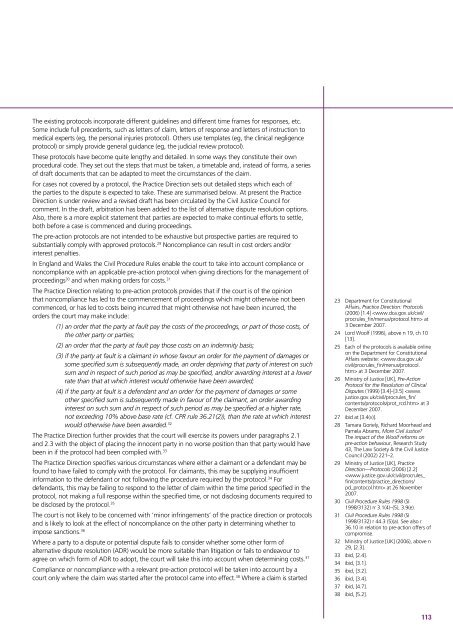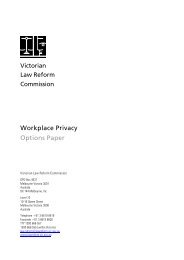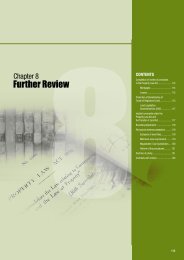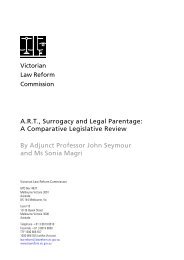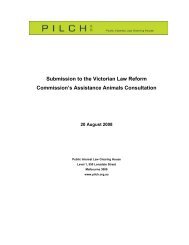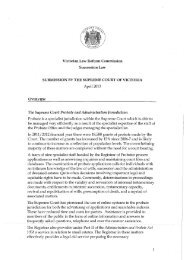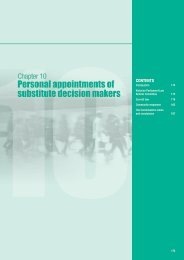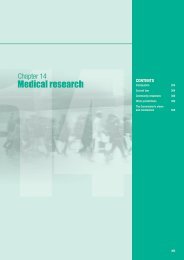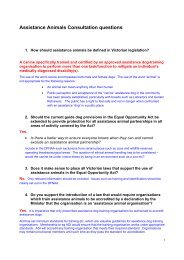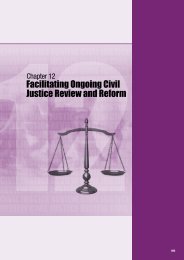Facilitating the Early Resolution of Disputes without Litigation
Facilitating the Early Resolution of Disputes without Litigation
Facilitating the Early Resolution of Disputes without Litigation
Create successful ePaper yourself
Turn your PDF publications into a flip-book with our unique Google optimized e-Paper software.
The existing protocols incorporate different guidelines and different time frames for responses, etc.Some include full precedents, such as letters <strong>of</strong> claim, letters <strong>of</strong> response and letters <strong>of</strong> instruction tomedical experts (eg, <strong>the</strong> personal injuries protocol). O<strong>the</strong>rs use templates (eg, <strong>the</strong> clinical negligenceprotocol) or simply provide general guidance (eg, <strong>the</strong> judicial review protocol).These protocols have become quite lengthy and detailed. In some ways <strong>the</strong>y constitute <strong>the</strong>ir ownprocedural code. They set out <strong>the</strong> steps that must be taken, a timetable and, instead <strong>of</strong> forms, a series<strong>of</strong> draft documents that can be adapted to meet <strong>the</strong> circumstances <strong>of</strong> <strong>the</strong> claim.For cases not covered by a protocol, <strong>the</strong> Practice Direction sets out detailed steps which each <strong>of</strong><strong>the</strong> parties to <strong>the</strong> dispute is expected to take. These are summarised below. At present <strong>the</strong> PracticeDirection is under review and a revised draft has been circulated by <strong>the</strong> Civil Justice Council forcomment. In <strong>the</strong> draft, arbitration has been added to <strong>the</strong> list <strong>of</strong> alternative dispute resolution options.Also, <strong>the</strong>re is a more explicit statement that parties are expected to make continual efforts to settle,both before a case is commenced and during proceedings.The pre-action protocols are not intended to be exhaustive but prospective parties are required tosubstantially comply with approved protocols. 29 Noncompliance can result in cost orders and/orinterest penalties.In England and Wales <strong>the</strong> Civil Procedure Rules enable <strong>the</strong> court to take into account compliance ornoncompliance with an applicable pre-action protocol when giving directions for <strong>the</strong> management <strong>of</strong>proceedings 30 and when making orders for costs. 31The Practice Direction relating to pre-action protocols provides that if <strong>the</strong> court is <strong>of</strong> <strong>the</strong> opinionthat noncompliance has led to <strong>the</strong> commencement <strong>of</strong> proceedings which might o<strong>the</strong>rwise not beencommenced, or has led to costs being incurred that might o<strong>the</strong>rwise not have been incurred, <strong>the</strong>orders <strong>the</strong> court may make include:(1) an order that <strong>the</strong> party at fault pay <strong>the</strong> costs <strong>of</strong> <strong>the</strong> proceedings, or part <strong>of</strong> those costs, <strong>of</strong><strong>the</strong> o<strong>the</strong>r party or parties;(2) an order that <strong>the</strong> party at fault pay those costs on an indemnity basis;(3) if <strong>the</strong> party at fault is a claimant in whose favour an order for <strong>the</strong> payment <strong>of</strong> damages orsome specified sum is subsequently made, an order depriving that party <strong>of</strong> interest on suchsum and in respect <strong>of</strong> such period as may be specified, and/or awarding interest at a lowerrate than that at which interest would o<strong>the</strong>rwise have been awarded;(4) if <strong>the</strong> party at fault is a defendant and an order for <strong>the</strong> payment <strong>of</strong> damages or someo<strong>the</strong>r specified sum is subsequently made in favour <strong>of</strong> <strong>the</strong> claimant, an order awardinginterest on such sum and in respect <strong>of</strong> such period as may be specified at a higher rate,not exceeding 10% above base rate (cf. CPR rule 36.21(2)), than <strong>the</strong> rate at which interestwould o<strong>the</strong>rwise have been awarded. 32The Practice Direction fur<strong>the</strong>r provides that <strong>the</strong> court will exercise its powers under paragraphs 2.1and 2.3 with <strong>the</strong> object <strong>of</strong> placing <strong>the</strong> innocent party in no worse position than that party would havebeen in if <strong>the</strong> protocol had been complied with. 33The Practice Direction specifies various circumstances where ei<strong>the</strong>r a claimant or a defendant may befound to have failed to comply with <strong>the</strong> protocol. For claimants, this may be supplying insufficientinformation to <strong>the</strong> defendant or not following <strong>the</strong> procedure required by <strong>the</strong> protocol. 34 Fordefendants, this may be failing to respond to <strong>the</strong> letter <strong>of</strong> claim within <strong>the</strong> time period specified in <strong>the</strong>protocol, not making a full response within <strong>the</strong> specified time, or not disclosing documents required tobe disclosed by <strong>the</strong> protocol. 35The court is not likely to be concerned with ‘minor infringements’ <strong>of</strong> <strong>the</strong> practice direction or protocolsand is likely to look at <strong>the</strong> effect <strong>of</strong> noncompliance on <strong>the</strong> o<strong>the</strong>r party in determining whe<strong>the</strong>r toimpose sanctions. 36Where a party to a dispute or potential dispute fails to consider whe<strong>the</strong>r some o<strong>the</strong>r form <strong>of</strong>alternative dispute resolution (ADR) would be more suitable than litigation or fails to endeavour toagree on which form <strong>of</strong> ADR to adopt, <strong>the</strong> court will take this into account when determining costs. 37Compliance or noncompliance with a relevant pre-action protocol will be taken into account by acourt only where <strong>the</strong> claim was started after <strong>the</strong> protocol came into effect. 38 Where a claim is started23 Department for ConstitutionalAffairs, Practice Direction: Protocols(2006) [1.4] at3 December 2007.24 Lord Woolf (1996), above n 19, ch 10[13].25 Each <strong>of</strong> <strong>the</strong> protocols is available onlineon <strong>the</strong> Department for ConstitutionalAffairs website: at 3 December 2007.26 Ministry <strong>of</strong> Justice [UK], Pre-ActionProtocol for <strong>the</strong> <strong>Resolution</strong> <strong>of</strong> Clinical<strong>Disputes</strong> (1999) [3.4]–[3.5] at 3December 2007.27 ibid at [3.4(v)].28 Tamara Goriely, Richard Moorhead andPamela Abrams, More Civil Justice?The impact <strong>of</strong> <strong>the</strong> Woolf reforms onpre-action behaviour, Research Study43, The Law Society & <strong>the</strong> Civil JusticeCouncil (2002) 221–2.29 Ministry <strong>of</strong> Justice [UK], PracticeDirection—Protocols (2006) [2.2] at 26 November2007.30 Civil Procedure Rules 1998 (SI1998/3132) rr 3.1(4)–(5), 3.9(e).31 Civil Procedure Rules 1998 (SI1998/3132) r 44.3 (5)(a). See also r36.10 in relation to pre-action <strong>of</strong>fers <strong>of</strong>compromise.32 Ministry <strong>of</strong> Justice [UK] (2006), above n29, [2.3].33 ibid, [2.4].34 ibid, [3.1].35 ibid, [3.2].36 ibid, [3.4].37 ibid, [4.7].38 ibid, [5.2].113


